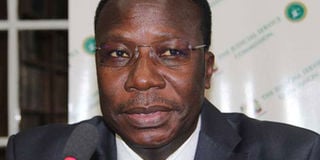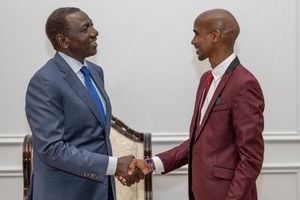Kenya's past chief justices and their qualities

Judge Smokin Wanjala appears at the Supreme Court for an interview for the position of chief justice on September 3, 2016. He came second with 74 per cent. PHOTO | DENNIS ONSONGO | NATION MEDIA GROUP
What you need to know:
- Controversial US-based law professor Makau Mutua, who had not initially been short-listed, unexpectedly emerged third with 72 per cent.
- Mr Daniel Waisiko Wambura, a principal administrative secretary in the office of the Deputy President, is said to have come last, with a 30 per cent score.
Court of Appeal Judge David Maraga emerged tops in the Judicial Service Commission interviews with more than 10 per cent points above the rest.
He scored an impressive 84 per cent, with Commissioner Tom Ojienda, saying he topped on all fronts, and hence the JSC did not struggle in picking the winner.
Supreme Court Judge Smokin Wanjala came second with 74 per cent.
Controversial US-based law professor Makau Mutua, who had not initially been short-listed, unexpectedly emerged third with 72 per cent.
Court of Appeal Judge Alnashir Visram was fourth, while former Law Society of Kenya chairman Nzamba Kitonga came fifth followed by Supreme Court Judge Jackton Ojwang.
Court of Appeal Judge Roselyne Nambuye was seventh.
Mr Daniel Waisiko Wambura, a principal administrative secretary in the office of the Deputy President, is said to have come last, with a 30 per cent score.
Retired judge Aaron Ringera emerged slightly above Mr Wambura, but also in the 30s percentage.
However, some commissioners denied that the interviewees had been ranked.
PAST CJss
1. Sir Alfred John Ainley, 1963 to 1968: Appointed by the Queen in 1963, he arrived in Kenya at a time when the transition to Independence was on. He witnessed the swearing-in of Jomo Kenyatta as the Prime Minister in 1963 and a year later as Kenya’s first president. One of the most notable cases that he heard was that on murder of Pio Gama Pinto, who was a Member of Parliament in Nairobi. He sentenced Kisilu Mutua to death. This was later commuted to 35 years.
He presided over a wholly British judiciary.
****
2. Arthur Dennis Farrel, May 1968 to July, 1968: When he reduced the sentence of Bildad Kaggia from one year to six months, Farrel fell out with the Kenyatta system. Apparently, Kaggia had dared the Kenyatta government by holding a political rally without a licence, a requirement carried forward from the colonial era. When Kaggia appealed, Justice Farrel and Justice Dalton upheld the conviction, but reduced the sentence to six months. That day, Kenyatta appointed a new chief justice.
****
3. Kitili Mwendwa, 1968 to 1971:Before he was linked to the 1971 coup attempt against Jomo Kenyatta, Mwendwa had become the first indigenous Chief Justice. He was only 39 when he was appointed to this position. He, together with Chief of Defence Staff, Maj-Gen Ndolo, would be implicated in a coup plot by Yatta MP Gideon Mutiso, but Mzee Kenyatta allowed them to only step down from their positions without facing any trial. Mwendwa died in a car crash in September 1985. Ndolo had also died in a car crash in 1984.
****
4. Sir James Wicks, 1971 to 1982: Best remembered as the person who swore in President Moi shortly after the death of Jomo Kenyatta in 1978, Sir James Wicks had been by-passed in the appointment of Mwendwa and served the two presidencies. He remains Kenya’s longest serving Chief Justice, with 11 years. During his tenure, the Executive and the Judiciary became cosy. His era saw the retirement age of judges amended three times to accommodate his age, from 70 to 72 and, finally, 74.
****
5. Sir Alfred Simpson, 1982 to 1985: Many Kenyans had never heard about Alfred Simpson until he presided over the murder trial of Cabinet Minister Tom Mboya in 1969. He presided over the famous Nathan Kahara case, which allowed a private citizen to pursue private criminal prosecution at the High Court. Another epic trial that he handled was the Andrew Mungai Muthemba case, in which the businessman had been charged with treason. He released him, to the chagrin of many who had followed the case with vested interests.
****
6. CB Madan, 1985 to 1986: A poet, one of his creations was adopted by the music group Them Mushrooms. He heard the famous Githunguri case when the government wanted to open a concluded prosecution. In his poetic ruling, he wrote: “You have been beseeching the court for an order of prohibition. Take the order. The court gives it to you. When you leave, raise your eyes to the hills. Utter a prayer of thankfulness that your fundamental rights are protected under the judicial system of Kenya!”
****
7. Cecil Miller, 1986 to 1989: Justice Miller came to the limelight in 1982, when he was appointed chairman of the judicial commission inquiring into allegations involving former Attorney-General Charles Njonjo. Born in Guyana, he was for years the only black face at the Court of Appeal and had previously headed the Law Reform Commission. A former Air Force pilot, Miller used his new office to intimidate independent judges and it was during his term that the security of tenure for judges and Chief Justice was removed.
****
8. Allan Hancox, 1989 to 1992: He joined the Court of Appeal in 1982, and served as chairman of the law Reform Commission from 1987 until his appointment as Chief Justice. Under his watch that the Judiciary became a tool for the Executive and followed in the footsteps of his stepfather, former chief Justice James Wicks. He upheld the one-party system when it was challenged in court and also ensured that all political cases were handled by the pro-system Justice Norbury Dugdale, whom he had appointed as a permanent duty judge.
****
9. Fred Kwasi Apaloo, 1992 to 1995: One of the most independent legal minds to hold that position, Justice Apaloo had studied law in England. After serving in his native Ghana, where he rose to become his country’s Chief Justice in 1966, and later to the Supreme Court, he came to Kenya with a rather independent background and had survived attempts to remove him from office. Coming at a time when the country had seen the reintroduction of multi-party politics, Apaloo’s tenure was, however, colourless.
****
10. Abdul Majid Cockar, 1995 to 1997: Perhaps the only judge who drove himself to work and had no bodyguard, Justice Cockar was in a class of his own. From his residence in Nairobi South C, which he refused to vacate upon his appointment as CJ, he followed the Uhuru Highway traffic jam in his Peugeot 504 without showing off the might of his office. Perhaps it was that frugal lifestyle that distinguished him from the other CJs. He was, however, seen as a weak administrator, given that he did not offer any command.
****
11. Zacchaeus Chesoni, 1997 to 1999: The appointment of Chesoni to replace Cockar was widely seen as a reward for his handling of the 1992 and 1997 General Elections, and a signal that President Moi was not willing to see an independent Judiciary. Others said the Executive did not want a clean-up of the corruption bedeviling the institution. He had overseen the rigging of the General Election in favour of Kanu, and as Chief Justice he was to oversee election petitions of an electoral system that he had been part of. He died in office.
****
12. Bernard Chunga, 1999 to 2003: The third indigenous Kenyan to hold the office, Chunga had been mired in controversy when he was the Deputy Public Prosecutor on the way he handled the Mwakenya cases. A man who was very close to President Moi, he oversaw the transition from Kanu to Narc. Months later he was forced to step down after a tribunal was set up to investigate his alleged misconduct. To his credit, he revived the activities of the Law Reporting board and allocated them a share of finances from Judiciary’s budget.




